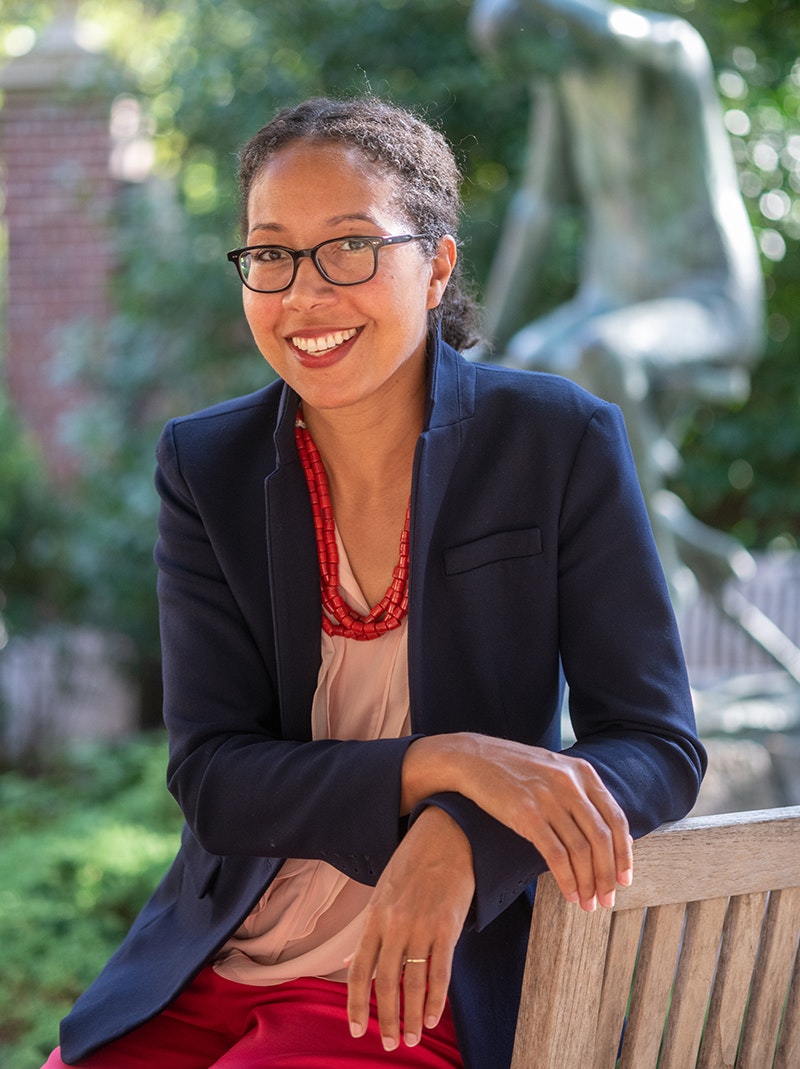An Expanded Historical Narrative

Elizabeth A. Herbin-Triant is uncovering complicated attitudes toward slavery in pre–Civil War Lowell, Massachusetts.
John Levy was born on the Caribbean island of Nevis in 1797. In his early years, he worked as a cabin and steward boy on ships, eventually making his way to Cambridge, where he performed odd jobs for students on Harvard’s campus.
But it was in the bustling mill town of Lowell, Massachusetts, that Levy found his calling, spreading an antislavery message in his small barber shop in the 1830s and 1840s. Catering to white workers who toiled in the city’s booming textile mills, Levy challenged his customers’ views on slavery while he cut their hair or shaved their faces. In doing so, as he put it in his 1871 memoir, he rendered himself “obnoxious to the people to whom the question was distasteful.” Levy also sold William Lloyd Garrison’s abolitionist newspaper the Liberator from his shop.
For Elizabeth A. Herbin-Triant, the 2022–2023 Radcliffe Institute Fellow, the barber-turned-activist was one of several key players in the city’s abolitionist community making a difference during the antebellum era.
“People’s thinking was influenced by the conversations taking place in Levy’s shop,” says the author and Amherst College historian. Lowell’s complicated history is the focus of her latest book, “Spindles & Slavery: Abolitionists, Anti-Abolitionists, and the Business of Manufacturing Cotton Grown by the Enslaved.”
At the same time that antislavery efforts were unfolding in Lowell, the city’s textile industry was developing strong financial ties to the cotton South. “New England played an important role in supporting slavery,” says Herbin-Triant, who is working to tell a neglected story about Lowell’s past. “New Englanders bought cotton from enslavers and then sold it as textiles, including what was called ‘Negro’ or Lowell cloth, back to plantation owners for the enslaved to wear.”
For the author, Lowell offered up a perfect case study showing New Englanders pulled between supporting slavery and fighting against it. Fueled by waterpower from the Merrimack River’s Pawtucket Falls, the city became a major center of textile manufacturing during the industrial revolution. At one point, most residents made their livelihood either directly or indirectly off the production of cloth from cotton grown by the enslaved, says Herbin-Triant—from managers in the mills and local shopkeepers to mill workers.
“Some of these folks, including mill girls, recognized that slavery was wrong and started participating in the antislavery movement, even while their employers were actively protecting slavery,” says Herbin-Triant, who took her first tour of the city several years ago and knew immediately she wanted “to know more.”
Her current work is in line with Harvard University’s recent 131-page report issued by a committee appointed by Harvard President Larry Bacow and led by Radcliffe Dean Tomiko Brown-Nagin that details the ways many early Harvard benefactors profited from the work of the enslaved. The many examples, while not comprehensive, “illustrate the multifaceted ties between Harvard’s major donors and slavery, the slave trade, and the trade in slave-produced goods,” the report notes.
Herbin-Triant says she hopes her book project “will contribute toward the research on Harvard’s connections to slavery.”
She also hopes to shine a light on figures such as Levy, who hosted abolitionists speeches in Lowell (which in at least one case involved protecting a speaker from an angry mob) and supported fugitives from slavery. Stories of mill workers troubled by the knowledge that the cotton they wove into cloth was rooted in slavery and who signed abolitionist petitions yet remained in their jobs will also appear in Herbin-Triant’s pages.
“It’s so interesting to look at the degrees of pro- and antislavery activity in the city, as there were a range of actions people were willing to take. I want to understand what inspired people who were at a geographical distance from slavery to take action against it,” says the author. Of particular interest to Herbin-Triant is how fugitives from slavery “taught Lowell residents about their experiences and inspired antislavery activism.”

Herbin-Triant wants "want to understand what inspired people who were at a geographical distance from slavery to take action against it," she says. Photo by Lou Jones
Radcliffe is a homecoming of sorts for Herbin-Triant, who studied history and literature at Harvard College. The New York native met her future husband in her first-year dorm and was inspired by Evelyn Brooks Higginbotham, the Victor S. Thomas Professor of History and of African and African American Studies, to delve deeper into the past. It was a historiography course taught by Higginbotham, recalls Herbin-Triant, that helped her see how the narrative of slavery had shifted, as historians moved from embracing the perspective of the plantation owners who considered slavery a “benign institution” to investigating the experiences of the enslaved.
“To see that history is not just a set of facts that you memorize, and that the way scholars interpret it changes with each generation, was really interesting to me,” says Herbin-Triant, “and it connects to my work today, in that I’m thinking about the ways Northerners facilitated slavery and how and why their support for the institution of slavery has been edited out of the conversation.”
Access to Harvard’s libraries and archives is proving key to Herbin-Triant’s research. She’s pored over financial records of Lowell’s textile mills at Harvard Business School and combed through diaries and letters written by the mill worker Harriet Jane Hanson Robinson at the Schlesinger Library. She’s also connecting with Harvard experts whose scholarship is informing her work. Research on petitions by the political scientist and Allie S. Freed Professor of Government Daniel Carpenter RI ’08 has helped her understand how such appeals circulated through Lowell. During the winter break, she met with Harvard’s Laird Bell Professor of History Sven Beckert, the author of Empire of Cotton: A Global History (Knopf, 2014). (Beckert’s work with a group of students in 2007 became some of the first efforts to study Harvard’s ties to slavery in detail.) And she is planning to connect with Tiya Miles RI ’22, a Radcliffe Alumnae Professor, the Michael Garvey Professor of History, a 2011 MacArthur Fellow, and a 2021 National Book Award winner for All That She Carried: The Journey of Ashley’s Sack, a Black Family Keepsake (Random House, 2021), which uses a cloth sack given by an enslaved woman to her daughter as a window into women’s experiences of slavery. Herbin-Triant says she considers Miles’s book The Dawn of Detroit: A Chronicle of Slavery and Freedom in the City of the Straits (New Press, 2017) a model for her own.
The author and Radcliffe fellow hopes her latest book can contribute to the ongoing effort to expand the historical narrative around slavery through initiatives such as the New York Times’ 1619 Project and critical race theory, the academic and legal framework that focuses on how racism has shaped American society.
“We should really be confronting the complexity of the history of our own region,” says Herbin-Triant, “and not just pointing fingers at the white South, because so much was happening here as well.”
Colleen Walsh is a freelance writer.







